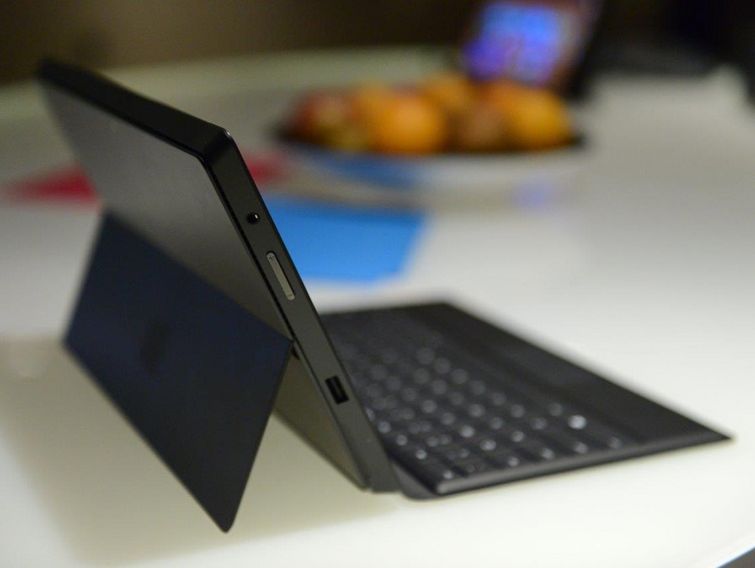Microsoft Surface Pro review
The 10.6in Windows 8 hybrid tablet finally launches in the UK, but it's not worth the wait.
The Surface Pro fails to live up to expectations. Despite the HD screen and solid performance, it's weak when it comes to portability and doesn't do enough to stand out from OEM competitors.
-
+
Beautiful HD screen; Full Windows 8; Good performance
-
-
Inflexible kickstand; Too heavy; Expensive; Virtually unserviceable; So-so battery life
Performance and Ports
One of the few positives of the Surface Pro is performance. The Core i5 Ivy Bridge dual-core processor is clocked at 1.7GHz and back up by 4GB of RAM.
The use of Intel chips means the full-fat edition of Windows 8 Pro is re-loaded. This allows users to install and run legacy applications out-of-the-box, something the Surface RT cannot do. You've also got access to the Live Tile interface and the Windows Store, so you can download any applications, TV shows, films and music.
In our real-world benchmarks test, the Pro scored a solid 0.6 blowing competitors like the Dell Latitude 10 (0.22) and ThinkPad 2 (0.17) out of the water. This puts the Surface up there with Ultrabook performance and it should be able to run taxing applications and a multi-monitor setup.
The device does get hot when it's being pushed to its limits, and the fan kicks in.

Microsoft has kitted out the Pro with a handful of useful ports - the USB 3 connection allows you to add in a peripheral, and storage can be boosted through the micro SDXC card slot. As mentioned, the microDisplay port allows you to sync up to a monitor.
In the absence of an Ethernet jack, the primary method to connect to the web is through Wi-Fi. The Pro supports 802.11a/b/g/n connectivity. Bluetooth 4 is built-in allowing you to communicate with a variety of devices and peripherals.
Display and Pen
The Surface Pro packs a 10.6in display with a full HD 1920 x 1080 resolution. The screen is the same size as Surface RT, but the Pro has over one million more pixels sized into it.
Microsoft has used its ClearType display technology, which make colours jump out of the screen. The Pro's got a maximum brightness of 446 cd/m2, just shy of the 448cd/m2 acheived by the rival Dell Latitude 10. It's one of the sharpest displays we've seen on a non-Apple tablet and this makes the Surface Pro ideal for flipping through magazines or watching HD movies.
A stylus is include with the Pro in an attempt to attract business users. This can be useful for editing document and charts and for those who want to use the Surface Pro for design purposes.
Microsoft claims the device is able to recognise 1,024 levels of pressure, but you're not going to feel this. There's a slight delay in between writing something on screen and it appearing, but we're talking milliseconds.
There were reports the pen was not functioning correctly with applications such as Photoshop. Microsoft has upgraded a pressure API to fix this issue.
It's surprising the free One Note app is not pre-installed on the Pro, as this is ideal for jotting down notes and sketches with the stylus.

One of the main concerns is the pen will be lost. When it's not being used, the pen clips into the magnetic charging dock on the right-hand side of the device. When you charge your device, you have no choice but to unclip the pen, and this is the time when it's most likely to get lost.
Devices such as the Lenovo ThinkPad 2 have a special dock where the pen can be housed at all times, and Microsoft should have done the same.
Get the ITPro daily newsletter
Sign up today and you will receive a free copy of our Future Focus 2025 report - the leading guidance on AI, cybersecurity and other IT challenges as per 700+ senior executives
-
 ‘Phishing kits are a force multiplier': Cheap cyber crime kits can be bought on the dark web for less than $25 – and experts warn it’s lowering the barrier of entry for amateur hackers
‘Phishing kits are a force multiplier': Cheap cyber crime kits can be bought on the dark web for less than $25 – and experts warn it’s lowering the barrier of entry for amateur hackersNews Research from NordVPN shows phishing kits are now widely available on the dark web and via messaging apps like Telegram, and are often selling for less than $25.
By Emma Woollacott Published
-
 Redis unveils new tools for developers working on AI applications
Redis unveils new tools for developers working on AI applicationsNews Redis has announced new tools aimed at making it easier for AI developers to build applications and optimize large language model (LLM) outputs.
By Ross Kelly Published
-
 Google layoffs continue with "hundreds" cut from Chrome, Android, and Pixel teams
Google layoffs continue with "hundreds" cut from Chrome, Android, and Pixel teamsNews The tech giant's efficiency drive enters a third year with devices teams the latest target
By Bobby Hellard Published